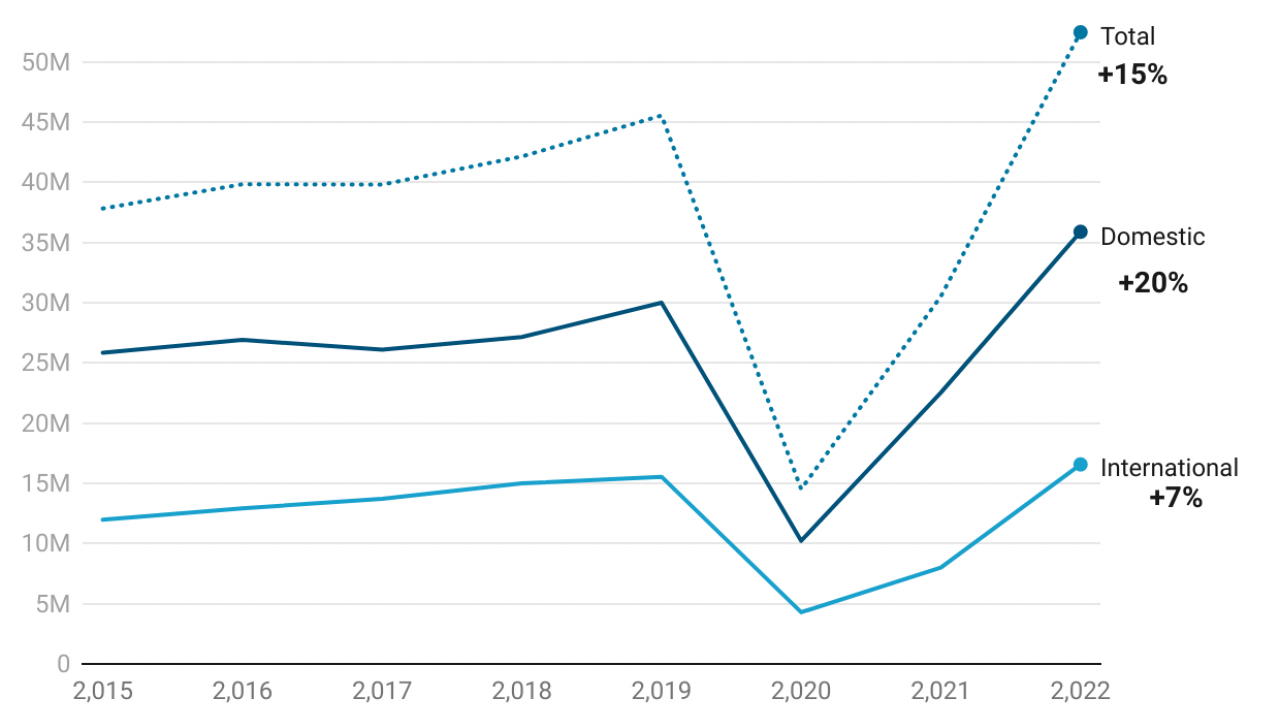Colombia Sees Exceptional Air Traffic Recovery, up to 60% Above Pre-Pandemic (Part 1 of 2)
Dion Zumbrink
February 15, 2023

Bogota skyline, Colombia.
© Random Institute/Unsplash
While global air traffic reached almost 77% of 2019 levels in December, one country, in particular, has seen an incredible recovery, starting in the second half of 2021 and throughout 2022.
After a complete shutdown of commercial air traffic for five months in 2020 and a staged reopening of routes, Colombian air passenger volumes have continued to rise well above 2019 levels. This occurred while the two largest airlines were under Chapter 11 bankruptcy protection.
As you can see from the chart below, total traffic volume in Colombia is up by 15% compared to 2019. Domestic traffic accounts for most of the growth, but even international traffic in 2022 was almost 7% above pre-pandemic levels.

Air traffic in Colombia has bounced back remarkably fast, driven by domestic travel.
Where is the Growth Happening?
Bogota, the capital, has seen a milder recovery of just 1% above 2019 and brings down the overall statistics due to its weight in overall Colombian traffic. However, when looking in more detail, it is remarkable that all other major airports in Colombia are seeing 30% to 50% increases versus pre-pandemic, and in the case of Santa Marta Airport even 60% growth.
Bogota's slower recovery could be attributed to the higher share of international traffic, foreign network carriers, and capacity restrictions preventing it from growing much over the current volumes.
When looking at the distribution of airlines in the overall market we can see that the main growth is coming from LATAM, Viva Colombia, and Wingo, which have grown 40%, 77%, and 42% respectively compared to 2019. The only airlines which have not reached pre-pandemic levels yet are Avianca and Easyfly.
Furthermore, it is interesting to note that U.S. carriers such as American and Spirit have shown a particular interest in the market, with both nearly doubling passenger traffic to the country.

Traffic growth at Colombia's airports vary wildly from 60% above pre-pandemic at Santa Marta to just 1% at Bogota.
The Key Reasons Driving an Exceptional Rebound
One of the main reasons for the growth of secondary airports is the increased number of direct connections offered. Whereas before often the best, or only, travel option included a stop in Bogota, nowadays both the low-cost airlines as well as Avianca and foreign airlines, focused on opening more direct routes between secondary cities in the country. This also includes more direct connections to international destinations.
The growth was partly enabled by the emergence of the low-cost model at a large scale. Historically, Colombia has had a limited market share of low-cost airlines compared to the wider region, but is catching up with the new airline Ultra Air. The carrier launched operations in March 2022 and currently operates a fleet of six A320-200s.
Ultra Air is set to grow and add 10 more domestic and over 30 international routes to its network in 2023. Additionally, Viva Air Colombia increased its passenger volume by 77% compared to 2019, the largest growth of all Colombian airlines.
Behind the strong capacity increase of airlines was government support, decreasing VAT on airline tickets from 19% to 5%. Additionally, the tourism industry was supported to reactivate and boost the economy, leading to increased domestic travel, as well as a large influx from international tourism, most notably from the United States.
Lastly, due to the government support of the national economy, the country has, after an initial strong impact on GDP, actually seen a stronger economic recovery than the regional and world averages.
In Part 2, next week, we will examine the factors that might impact the strength of the recovery seen so far.
